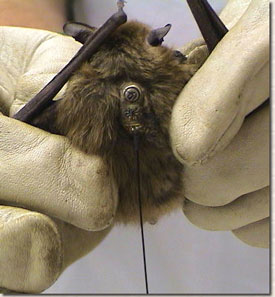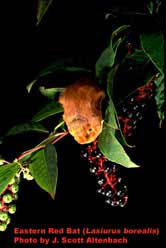- Home
- About S&T
- Taxa/Organisms
- Ecosystems
- Issues
- Methods & Tools
- Reports & Publications
- Location
- Search
Publisher: USGS | Science Center: Fort Collins Science Center (FORT, Ft. Collins) | Format: URL
www.fort.usgs.gov — In 1995, the Fort Collins Science Center, Biological Resources Discipline, United States Geological Survey initiated a cooperative study with the National Park Service to study the bats of Jewel Cave National Monument. The major goals of this project were to define distribution patterns and roosting habits of bats in the area. One of the More...

Publisher: USGS | Science Center: Columbia Environmental Research Center (CERC, Columbia) | Format: URL
www.cerc.usgs.gov — The BFRS works cooperatively with team members from CERC and with faculty and graduate students of Department of Wildlife and Fisheries Sciences at Texas A&M University in research areas represented by the branch structure of the CERC including toxicology, ecology, biochemistry and physiology, environmental chemistry, ecogeography, and information More...

Publisher: NBII | Format: URL
pollinators.nbii.gov — The global declines in many kinds of pollinator species could potentially impact the global food supply, as many plants depend upon specific pollinators to reproduce. The Web site of the NBII Pollinators Project provides access to information about the biology, ecology, conservation status, and threats to native pollinators, pollinator-dependent More...

Publisher: USGS | Science Center: Fort Collins Science Center (FORT, Ft. Collins) | Format: URL
www.fort.usgs.gov — How do you study something that flies under cover of darkness? This question persistently troubles scientists investigating the mysterious lives of bats. The 45 bat species that occur in the continental United States play important roles in U.S. ecosystems as major predators of flying insects and pollinators of desert plants. Bats also play an More...

Publisher: USGS | Science Center: Western Ecological Research Center (WERC, Sacramento) | Format: URL
www.werc.usgs.gov — This site is a summary of bat research efforts by the USGS Western Ecological Research Center. From the site: "Scientists at the USGS Western Ecological Research Center are studying bats in the San Francisco Bay area and in southern California to provide land managers information they need regarding the occurrence and status of bat species." More...

Publisher: USGS | Science Center: Fort Collins Science Center (FORT, Ft. Collins) | Format: URL
www.fort.usgs.gov — Since the early part of the 20th century there have been several accounts of bat flocks appearing in strange places at strange times. However, our understanding of bat migration has advanced little. In hopes of learning more about the migratory habits of bats, USGS biologists Paul Cryan and Michael Bogan from the Arid Lands Field Station teamed up More...
